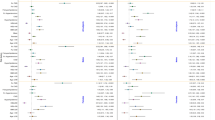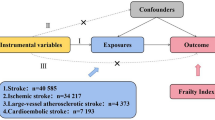Abstract
The development of ischemic stroke is associated with advanced age. Telomere length, as a marker of biological aging, has been reported to influence the risk of several age-related diseases, including ischemic stroke. Recent studies have identified the genetic variant within ACYP2 and TSPYL6 associated with shorter telomere length. The objective of this study is to investigate the putative association of ischemic stroke with common polymorphisms in ACYP2 and TSPYL6 genes in a Chinese Han population. We found that the risk alleles of six single nucleotide polymorphisms (SNPs), including rs11125529, rs12615793, rs843711, rs11896604, and rs843706 within both ACYP2 and TSPYL6, and rs17045754 in ACYP2 gene, were related with increased risk of ischemic stroke according to both allelic and genotype association analyses. The significant correlations between ACYP2 and TSPYL6 SNPs and ischemic stroke risk were also observed in dominant, recessive, and additive models, respectively. Two blocks in high linkage disequilibrium were identified in this study, and two haplotypes were associated with higher ischemic stroke susceptibility. In conclusion, the genetic polymorphisms of ACYP2 and TSPYL6 are associated with increased risk of developing ischemic stroke. Further studies with larger sample sizes are required to validate our findings.

Similar content being viewed by others
References
Krishnamurthi RV, Feigin VL, Forouzanfar MH, Mensah GA, Connor M, Bennett DA, Moran AE, Sacco RL et al (2013) Global and regional burden of first-ever ischaemic and haemorrhagic stroke during 1990–2010: findings from the Global Burden of Disease Study 2010. Lancet Glob Health 1(5):e259–e281. doi:10.1016/s2214-109x(13)70089-5
Feigin VL, Forouzanfar MH, Krishnamurthi R, Mensah GA, Connor M, Bennett DA, Moran AE, Sacco RL et al (2014) Global and regional burden of stroke during 1990–2010: findings from the Global Burden of Disease Study 2010. Lancet 383(9913):245–255
Vos T, Barber RM, Bell B, Bertozzi-Villa A, Biryukov S, Bolliger I, Charlson F, Davis A et al (2015) Global, regional, and national incidence, prevalence, and years lived with disability for 301 acute and chronic diseases and injuries in 188 countries, 1990–2013: a systematic analysis for the Global Burden of Disease Study 2013. Lancet 386(9995):743–800
Zhou M, Wang H, Zhu J, Chen W, Wang L, Liu S, Li Y, Wang L et al (2016) Cause-specific mortality for 240 causes in China during 1990–2013: a systematic subnational analysis for the Global Burden of Disease Study 2013. Lancet 387(10015):251–272. doi:10.1016/s0140-6736(15)00551-6
Bak S, Gaist D, Sindrup SH, Skytthe A, Christensen K (2002) Genetic liability in stroke a long-term follow-up study of Danish twins. Stroke J Cereb Circ 33(3):769–774
Jousilahti P, Rastenyte D, Tuomilehto J, Sarti C, Vartiainen E (1997) Parental history of cardiovascular disease and risk of stroke a prospective follow-up of 14 371 middle-aged men and women in Finland. Stroke J Cereb Circ 28(7):1361–1366
Blackburn EH, Greider CW, Szostak JW (2006) Telomeres and telomerase: the path from maize, Tetrahymena and yeast to human cancer and aging. Nat Med 12(10):1133–1138
Allsopp RC, Vaziri H, Patterson C, Goldstein S, Younglai EV, Futcher AB, Greider CW, Harley CB (1992) Telomere length predicts replicative capacity of human fibroblasts. Proc Natl Acad Sci 89(21):10114–10118
Njajou OT, Cawthon RM, Damcott CM, Wu S-H, Ott S, Garant MJ, Blackburn EH, Mitchell BD et al (2007) Telomere length is paternally inherited and is associated with parental lifespan. Proc Natl Acad Sci 104(29):12135–12139
Slagboom PE, Droog S, Boomsma DI (1994) Genetic determination of telomere size in humans: a twin study of three age groups. Am J Hum Genet 55(5):876
Vasa-Nicotera M, Brouilette S, Mangino M, Thompson JR, Braund P, Clemitson J-R, Mason A, Bodycote CL et al (2005) Mapping of a major locus that determines telomere length in humans. Am J Hum Genet 76(1):147–151
Benetos A, Gardner JP, Zureik M, Labat C, Xiaobin L, Adamopoulos C, Temmar M, Bean KE et al (2004) Short telomeres are associated with increased carotid atherosclerosis in hypertensive subjects. Hypertension 43(2):182–185
Brouilette S, Singh RK, Thompson JR, Goodall AH, Samani NJ (2003) White cell telomere length and risk of premature myocardial infarction. Arterioscler Thromb Vasc Biol 23(5):842–846
Brouilette SW, Moore JS, McMahon AD, Thompson JR, Ford I, Shepherd J, Packard CJ, Samani NJ et al (2007) Telomere length, risk of coronary heart disease, and statin treatment in the West of Scotland Primary Prevention Study: a nested case–control study. Lancet 369(9556):107–114
Ding H, Chen C, Shaffer JR, Liu L, Xu Y, Wang X, Hui R, Wang DW (2012) Telomere length and risk of stroke in Chinese. Stroke J Cereb Circ 43(3):658–663
Zee RY, Castonguay AJ, Barton NS, Ridker PM (2010) Relative leukocyte telomere length and risk of incident ischemic stroke in men: a prospective, nested case–control approach. Rejuvenation Res 13(4):411–414
Seng KC, Seng CK (2008) The success of the genome-wide association approach: a brief story of a long struggle. Eur J Hum Genet 16(5):554–564. doi:10.1038/ejhg.2008.12
Codd V, Nelson CP, Albrecht E, Mangino M, Deelen J, Buxton JL, Hottenga JJ, Fischer K et al (2013) Identification of seven loci affecting mean telomere length and their association with disease. Nat Genet 45(4):422–427. doi:10.1038/ng.2528, 427e421-422
Aouizerat BE, Vittinghoff E, Musone SL, Pawlikowska L, Kwok PY, Olgin JE, Tseng ZH (2011) GWAS for discovery and replication of genetic loci associated with sudden cardiac arrest in patients with coronary artery disease. BMC Cardiovasc Disord 11:29. doi:10.1186/1471-2261-11-29
Gabriel S, Ziaugra L, Tabbaa D (2009) SNP genotyping using the Sequenom MassARRAY iPLEX platform. Current protocols in human genetics / editorial board, Jonathan L Haines [et al.] Chapter 2:Unit 2 12. doi:10.1002/0471142905.hg0212s60
Li S, Jin T, Zhang J, Lou H, Yang B, Li Y, Chen C, Zhang Y (2012) Polymorphisms of TREH, IL4R and CCDC26 genes associated with risk of glioma. Cancer Epidemiol 36(3):283–287. doi:10.1016/j.canep.2011.12.011
Thomas RK, Baker AC, Debiasi RM, Winckler W, Laframboise T, Lin WM, Wang M, Feng W et al (2007) High-throughput oncogene mutation profiling in human cancer. Nat Genet 39(3):347–351. doi:10.1038/ng1975
Speedy HE, Di Bernardo MC, Sava GP, Dyer MJ, Holroyd A, Wang Y, Sunter NJ, Mansouri L et al (2014) A genome-wide association study identifies multiple susceptibility loci for chronic lymphocytic leukemia. Nat Genet 46(1):56–60. doi:10.1038/ng.2843
Hao RH, Guo Y, Dong SS, Weng GZ, Yan H, Zhu DL, Chen XF, Chen JB et al (2016) Associations of plasma FGF2 levels and polymorphisms in the FGF2 gene with obesity phenotypes in Han Chinese population. Sci Rep 6:19868. doi:10.1038/srep19868
Bland JM, Altman DG (2000) Statistics notes: the odds ratio. BMJ: Br Med J 320(7247):1468
Purcell S, Neale B, Todd-Brown K, Thomas L, Ferreira MA, Bender D, Maller J, Sklar P et al (2007) PLINK: a tool set for whole-genome association and population-based linkage analyses. Am J Hum Genet 81(3):559–575. doi:10.1086/519795
Barrett JC, Fry B, Maller J, Daly MJ (2005) Haploview: analysis and visualization of LD and haplotype maps. Bioinformatics 21(2):263–265. doi:10.1093/bioinformatics/bth457
Kim JW, Kwon OY, Kim MH (2007) Differentially expressed genes and morphological changes during lengthened immobilization in rat soleus muscle. Differ Res Biol Divers 75(2):147–157. doi:10.1111/j.1432-0436.2006.00118.x
Vos HI, Guchelaar HJ, Gelderblom H, de Bont ES, Kremer LC, Naber AM, Hakobjan MH, van der Graaf WT et al (2016) Replication of a genetic variant in ACYP2 associated with cisplatin-induced hearing loss in patients with osteosarcoma. Pharmacogenet Genomics. doi:10.1097/FPC.0000000000000212
Xu H, Robinson GW, Huang J, Lim JY, Zhang H, Bass JK, Broniscer A, Chintagumpala M et al (2015) Common variants in ACYP2 influence susceptibility to cisplatin-induced hearing loss. Nat Genet 47(3):263–266. doi:10.1038/ng.3217
Won HH, Lee J, Park JO, Park YS, Lim HY, Kang WK, Kim JW, Lee SY et al (2012) Polymorphic markers associated with severe oxaliplatin-induced, chronic peripheral neuropathy in colon cancer patients. Cancer 118(11):2828–2836. doi:10.1002/cncr.26614
Tao KP, Fong SW, Lu Z, Ching YP, Chan KW, Chan SY (2011) TSPYL2 is important for G1 checkpoint maintenance upon DNA damage. PLoS One 6(6):e21602. doi:10.1371/journal.pone.0021602
Acknowledgments
This work is supported by the Special Foundation for Public Health of Ministry of Health of China (No. 201002011). The authors are grateful to the scientists and staff from Northwest University for assistance in SNP genotyping.
Author information
Authors and Affiliations
Corresponding author
Ethics declarations
Conflict of Interest
The authors declare that they have no conflict of interest.
Additional information
Yiqian Liang and Rui Zhang contributed equally to this work.
Electronic Supplementary Material
Below is the link to the electronic supplementary material.
ESM 1
(DOCX 19 kb)
Rights and permissions
About this article
Cite this article
Liang, Y., Zhang, R., Zhang, S. et al. Association of ACYP2 and TSPYL6 Genetic Polymorphisms with Risk of Ischemic Stroke in Han Chinese Population. Mol Neurobiol 54, 5988–5995 (2017). https://doi.org/10.1007/s12035-016-0086-x
Received:
Accepted:
Published:
Issue Date:
DOI: https://doi.org/10.1007/s12035-016-0086-x




